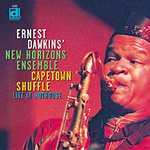|
|
 |
Dusted Reviews
Artist: Ernest Dawkins Album: Capetown Shuffle, Live at HotHouse Label: Delmark Review date: Nov. 20, 2003 |

|
|
|
 |
New York may be where all of the jazz musicians end up, but Chicago seems to be the American city where there really is a sound these days. Groups like the Vandermark 5, Kahil El’Zabar’s Ethnic Heritage Ensemble, Eight Bold Souls and Ernest Dawkins’ New Horizons Ensemble draw on the city’s history as a center for electric blues, rhythm and blues and, more recently, as a center for the cultural ferment of the ’60s that produced the stunning array of musicians affiliated with the Association of the Advancement of Creative Musicians. The current scene is full of heirs to AACM’s conflation of American jazz and blues music with African rhythmic and harmonic concepts, and most of the today’s key players are second-generation AACM members. The sound has the pulsing rhythmic insistence of early electric blues coupled with a musical sophistication injected by its years as a breeding ground for a more explorative breed of jazz.
Ernest Dawkins exemplifies Chicago’s history in his immediate influences and in his continuing dedication to the continuity of the city’s musical traditions. Dawkins grew up on Chicago’s South Side and quickly started to consume this legacy. He remembers hearing Anthony Braxton practicing in a building adjacent to his house. He started playing bass and conga drums when he was 12. After hearing his father’s recordings of Lester Young, he quickly became a reedsman and came under the tutelage of AACM members. Dawkins has always been dedicated to music education, getting a Masters degree in Music Education from Governors State University and continuing his studies at Vandercook and AACM Schools of Music. Furthering this education legacy has always been as important to him as playing the music; he began teaching in the Chicago Public School system in 1989 and before that had worked with Urban Gateway’s Education Performances Program.
Early in his performing career Dawkins was playing with working bands including Ed Wilkerson’s Shadow Vignettes Big Band, Douglas Ewart’s Clarinet Choir, and the AACM Big Band. His New Horizons Ensemble is cut from the same fabric. Since their beginning in the late ’70s, the Ensemble has been a live group. Nearly all of their recorded output, including albums on Silkheart, Open Minds, Dawkins’ own Dawk label and now two for Delmark, have been live albums. And the spontaneity and openness apparent on Cape Town Shuffle suggests that this specific lineup is among their very best. This is the kind of group that you pray are playing when you happen into a Chicago club on a blustery fall Tuesday.
“Toucoleur”, the album’s opening track, is built on two vamps, the first a relatively simple driving rhythm, the second a light polyrhythmic one, and provides a springboard for Dawkins, trumpeter Ameen Muhammad, and trombonist Steve Berry. Dawkins’ playing is grounded deeply in the blues and bebop, but has the exploratory energy that Coltrane and others introduced to the music. The band surges behind each soloist over the first vamp, lays back and catches its breath on the second, then launches full-force back into the first. Muhammad, who passed away not long after this recording was made, is brilliant throughout. His phrases have Gillespie’s agility and the swagger and slur of Lester Bowie (another much-missed Chicago trumpeter).
The album’s middle two tracks make explicit the cultural melding at the core of this music. “Third Line and the Cape Town Shuffle” is based on the rolling snare pattern of a New Orleans Second Line march, and the title draws a comparison between this and the music of Cape Town at Carnival time. “Dolphy and the Monk Dance” is self-explanatory: an off-kilter melody with strange intervallic movement built on 12-tone rows, one of Dolphy’s trademarks. On “Jazz to Hip Hop”, Kahari B. (son of AACM and Eight Bold Souls member Mwata Bowden) lays down some rhymes that ring with sincerity, much better the many similar attempts at melding jazz and hip-hop.
By Bruce Wallace
|







